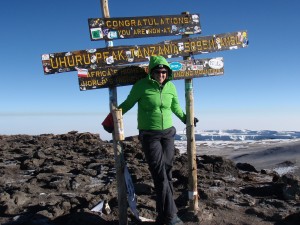Having been back at work a month, holidays are now seeming like a long time to go. This year I went to Tanzania and climbed Kilimanjaro (it’s always good to have a nice restful holiday to set yourself up for the next term). I hadn’t really looked into this before I left, assuming it would be a little like the Inca Trail but a bit higher. I had also been led to believe that this was the ‘easy’ route – it was a bit of a surprise to discover the morning we started that the ‘easy’ related to staying in huts rather than camping and this was actually the fastest ascent, and consequently the highest failure rate.
Altitude sickness is a funny thing and it’s hard to know how to prepare. It is not related to fitness, whether you’ve had it before or anything sensible. You are essentially taking pot luck. Some people had brought out altitude sickness medication which our guide helpfully advised not taking the day before getting to the summit as it can make you ill. Hmm.
By the time you get to 5000m the pressure difference with sea level really is significant. Walking really slow seems to take a surprising amount of effort. Taking the ascent more slowly allows the body to adapt to the differences in pressure. Athletes use high altitude training camps as it causes the number of oxygen carrying red blood cells to increase. Headaches are a common sympton in altitude sickness, caused by pressure differences in the brain. A less well advertised effect of the pressure difference is that one’s liquids tend to explode on one. Pretty much everyone had their hand gel/sun cream explode on them on the trip, leading to a short physics lesson on top of the mountain about what happens when the contents of a bottle that was last closed at sea level is opened in a much lower pressure atmosphere.
Just goes to show that on top of the highest mountain in Africa, there’s still physics everywhere.

